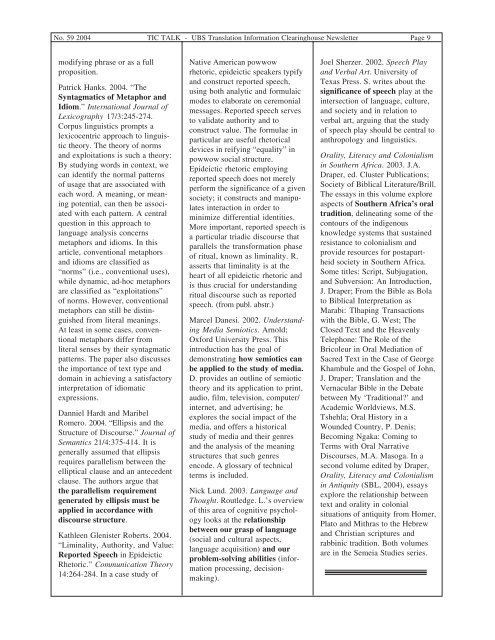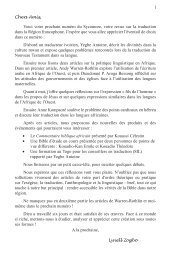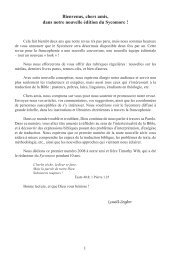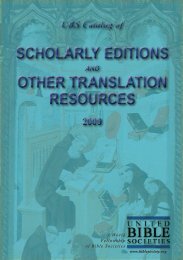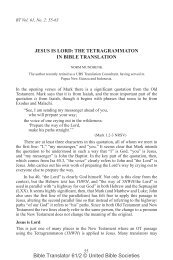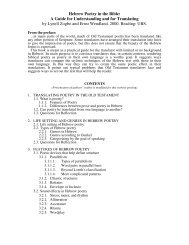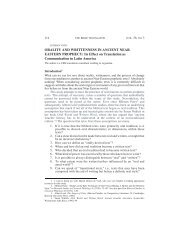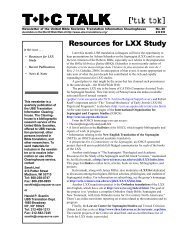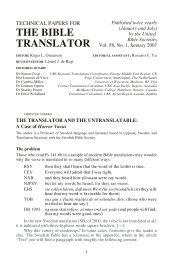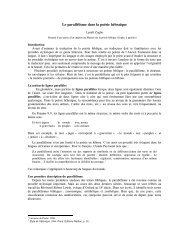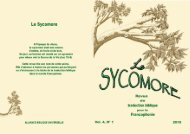TIC Talk - UBS Translations
TIC Talk - UBS Translations
TIC Talk - UBS Translations
Create successful ePaper yourself
Turn your PDF publications into a flip-book with our unique Google optimized e-Paper software.
No. 59 2004<strong>TIC</strong> TALK - <strong>UBS</strong> Translation Information Clearinghouse Newsletter Page 9modifying phrase or as a fullproposition.Patrick Hanks. 2004. “TheSyntagmatics of Metaphor andIdiom.” International Journal ofLexicography 17/3:245-274.Corpus linguistics prompts alexicocentric approach to linguistictheory. The theory of normsand exploitations is such a theory:By studying words in context, wecan identify the normal patternsof usage that are associated witheach word. A meaning, or meaningpotential, can then be associatedwith each pattern. A centralquestion in this approach tolanguage analysis concernsmetaphors and idioms. In thisarticle, conventional metaphorsand idioms are classified as“norms” (i.e., conventional uses),while dynamic, ad-hoc metaphorsare classified as “exploitations”of norms. However, conventionalmetaphors can still be distinguishedfrom literal meanings.At least in some cases, conventionalmetaphors differ fromliteral senses by their syntagmaticpatterns. The paper also discussesthe importance of text type anddomain in achieving a satisfactoryinterpretation of idiomaticexpressions.Danniel Hardt and MaribelRomero. 2004. “Ellipsis and theStructure of Discourse.” Journal ofSemantics 21/4:375-414. It isgenerally assumed that ellipsisrequires parallelism between theelliptical clause and an antecedentclause. The authors argue thatthe parallelism requirementgenerated by ellipsis must beapplied in accordance withdiscourse structure.Kathleen Glenister Roberts. 2004.“Liminality, Authority, and Value:Reported Speech in EpideicticRhetoric.” Communication Theory14:264-284. In a case study ofNative American powwowrhetoric, epideictic speakers typifyand construct reported speech,using both analytic and formulaicmodes to elaborate on ceremonialmessages. Reported speech servesto validate authority and toconstruct value. The formulae inparticular are useful rhetoricaldevices in reifying “equality” inpowwow social structure.Epideictic rhetoric employingreported speech does not merelyperform the significance of a givensociety; it constructs and manipulatesinteraction in order tominimize differential identities.More important, reported speech isa particular triadic discourse thatparallels the transformation phaseof ritual, known as liminality. R.asserts that liminality is at theheart of all epideictic rhetoric andis thus crucial for understandingritual discourse such as reportedspeech. (from publ. abstr.)Marcel Danesi. 2002. UnderstandingMedia Semiotics. Arnold;Oxford University Press. Thisintroduction has the goal ofdemonstrating how semiotics canbe applied to the study of media.D. provides an outline of semiotictheory and its application to print,audio, film, television, computer/internet, and advertising; heexplores the social impact of themedia, and offers a historicalstudy of media and their genresand the analysis of the meaningstructures that such genresencode. A glossary of technicalterms is included.Nick Lund. 2003. Language andThought. Routledge. L.’s overviewof this area of cognitive psychologylooks at the relationshipbetween our grasp of language(social and cultural aspects,language acquisition) and ourproblem-solving abilities (informationprocessing, decisionmaking).Joel Sherzer. 2002. Speech Playand Verbal Art. University ofTexas Press. S. writes about thesignificance of speech play at theintersection of language, culture,and society and in relation toverbal art, arguing that the studyof speech play should be central toanthropology and linguistics.Orality, Literacy and Colonialismin Southern Africa. 2003. J.A.Draper, ed. Cluster Publications;Society of Biblical Literature/Brill.The essays in this volume exploreaspects of Southern Africa’s oraltradition, delineating some of thecontours of the indigenousknowledge systems that sustainedresistance to colonialism andprovide resources for postapartheidsociety in Southern Africa.Some titles: Script, Subjugation,and Subversion: An Introduction,J. Draper; From the Bible as Bolato Biblical Interpretation asMarabi: Tlhaping Transactionswith the Bible, G. West; TheClosed Text and the HeavenlyTelephone: The Role of theBricoleur in Oral Mediation ofSacred Text in the Case of GeorgeKhambule and the Gospel of John,J. Draper; Translation and theVernacular Bible in the Debatebetween My ‘Traditional?’ andAcademic Worldviews, M.S.Tshehla; Oral History in aWounded Country, P. Denis;Becoming Ngaka: Coming toTerms with Oral NarrativeDiscourses, M.A. Masoga. In asecond volume edited by Draper,Orality, Literacy and Colonialismin Antiquity (SBL, 2004), essaysexplore the relationship betweentext and orality in colonialsituations of antiquity from Homer,Plato and Mithras to the Hebrewand Christian scriptures andrabbinic tradition. Both volumesare in the Semeia Studies series.


